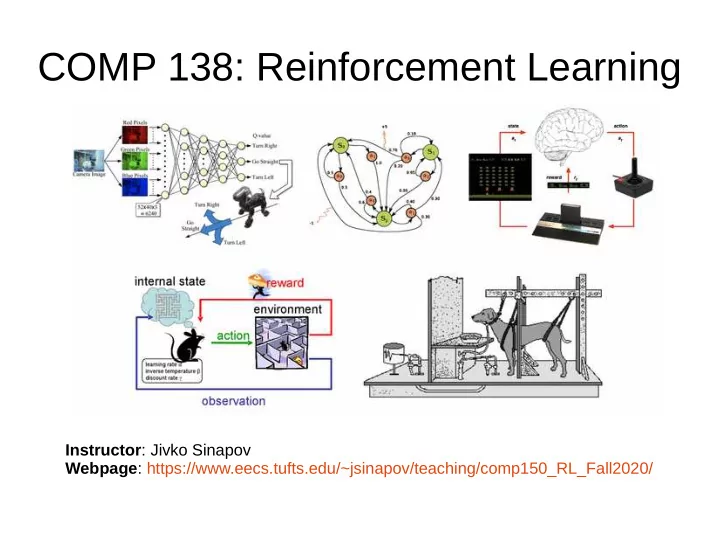

COMP 138: Reinforcement Learning Instructor : Jivko Sinapov Webpage : https://www.eecs.tufts.edu/~jsinapov/teaching/comp150_RL_Fall2020/
Announcements
Reading Assignment ● Chapter 6 of Sutton and Barto
Research Article Topics ● Transfer learning ● Learning with human demonstrations and/or advice ● Approximating q-functions with neural networks
Reading Assignment ● Chapter 6 of Sutton and Barto ● Matthew E. Taylor, Peter Stone, and Yaxin Liu. Transfer Learning via Inter-Task Mappings for Temporal Difference Learning . Journal of Machine Learning Research, 8(1):2125-2167, 2007. ● Responses should discuss both readings ● You get extra credit for answering others’ questions!
Programming Assignment #2 ● Homework 2 is out
Class Project Discussion ● What makes a good project? ● What makes a good team?
Reading Responses “What are some real word applications of DP?” - Boriana “Since there are at least four ways Monte Carlo methods are advantageous over DP mentioned, are there any problems in which using DP is more practical?” - Catherine
Reading Responses “How can we define the stopping conditions for value iteration or the Monte-Carlo method (how many iterations is enough)?” – Tung
Reading Responses “Are DP methods dependent on initial states?” – Eric
Reading Responses “In the Asynchronous Dynamic Programming method, according to what to choose which states should be updated more frequently?” – Pandong
Any other questions about DP?
Dynamic Programming
V 0 V 1 V 2 V 3 V 4 V 5 π = random policy 0 0 0 γ = 0.5 A 0 0 X/12 +X B 0 X/3 A B C C 0 X/6 D D 1/3 * 0.5 * x/12 + 1/3 * 0.5 * x/6 + x/3
V 0 V 1 V 2 V 3 V 4 V 5 π = random policy 0 γ = 0.5 A 0 2nd +X B 0 1st A B C C 0 D D 1/3 * 0.5 * x/12 + 1/3 * 0.5 * x/6 + x/3
V 0 V 1 V 2 V 3 V 4 V 5 π = optimal policy 0 γ = 0.5 A 0 +10 B 0 A B C C 0 D D At each state, the agent has 1 or more actions allowing it to move to neighboring states. Moving in the direction of a wall is not allowed WORKING TEXT AREA:
Policy Improvement ● Main idea: if for a particular state s , we can do better than following the current policy by taking a different action, then the current policy is not optimal and changing it to follow the different action at state s improves it
Policy Iteration ● evaluate → improve → evaluate → improve → …..
Value Iteration ● Main idea: – Do one sweep of policy evaluation under the current greedy policy – Repeat until values stop changing (relative to some small Δ)
V 0 V 1 V 2 V 3 V 4 V 5 π = greedy policy 0 γ = 0.5 A 0 +10 B 0 A B C C 0 D D At each state, the agent has 1 or more actions allowing it to move to neighboring states. Moving in the direction of a wall is not allowed WORKING TEXT AREA:
Monte Carlo Methods
Code Demo
Reading Responses “- What is the advantage and disadvantages of model-free method? What is the advantage and disadvantages of model-based method?” – Tung
Reading Responses “In theory, both DP and Monte Carlo will find optimal policy, but since our implementation of the method won't iterate infinitely, will there be chances that the result is only local optimal value” – Erli
Reading Responses “Are there situations when on-policy methods are preferred over off-policy for reasons other than ease of implementation?” – Eric
Finding Project Partner(s) Breakout
Monte Carlo Tree Search Video
THE END
Recommend
More recommend